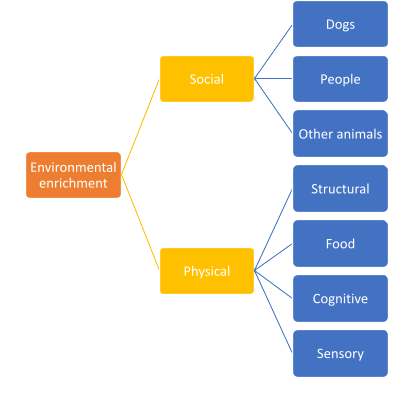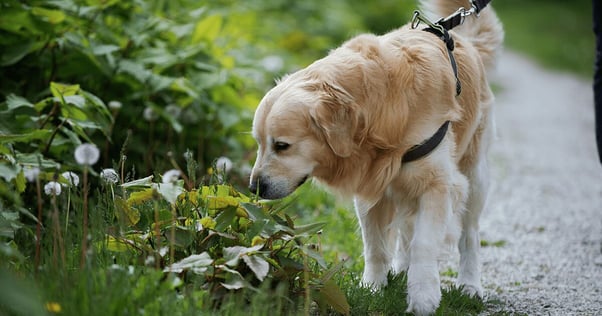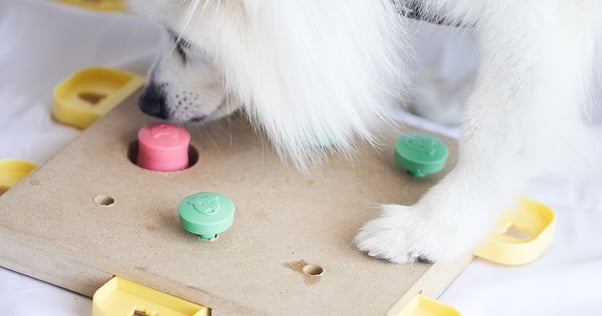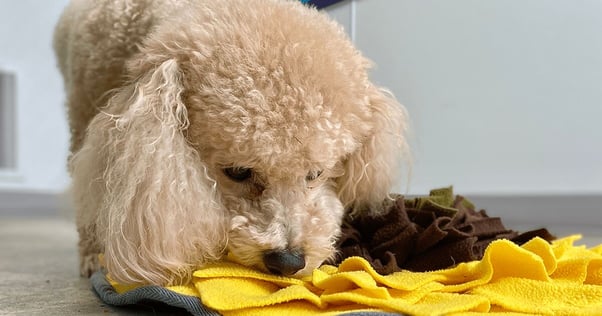Enriching Your Dog's Environment: A Happy Dog Expert Explains!
Have you ever wondered about the role environmental enrichment can have on a dog’s wellbeing? If so, you’re in the right place! We’re taking a closer look at the science behind this subject and exploring how you can introduce environmental enrichment for your dog at home.
What Do We Mean By Environmental Enrichment?
Canine environmental enrichment is a series of changes in a dog’s living environment that are generally intended to improve their wellbeing. It can be a tremendously important tool. If a dog has a behavioural problem, veterinary behaviour specialists will usually recommend a series of environmental enrichment guidelines as part of the treatment plan. Moreover, its application is necessary to prevent unwanted behaviour.
Enriching a dog’s environment does not have to be expensive financially. In fact, there are a lot of toys or elements that can be made at home. That being said, each dog is different. You may need to try a few things to find out what your dog responds well to.
Environmental enrichment for dogs can be classified into two categories. (see Figure 1):
Figure 1: Canine environmental enrichment scheme
 While social enrichment comes from a dog’s interactions with other living creatures – including humans and other dogs – physical enrichment refers more specifically to their immediate surroundings. Let’s explore this further.
While social enrichment comes from a dog’s interactions with other living creatures – including humans and other dogs – physical enrichment refers more specifically to their immediate surroundings. Let’s explore this further.
Physical Environmental Enrichment
Physical environmental enrichment usually corresponds to adding inanimate elements to a dog’s environment. We can break this down into a number of further categories:
Structural
The physical structure of a dog’s living space can be enhanced by adding vertical structures. These can then be used for climbing or even hiding in. In fact, it is always recommended that each dog has its own safe place.
A dog that lives in a house with a garden should have access to the house, the garden, and should be taken for daily walks for a chance to explore. Dogs should also be taken to new places periodically to further enrich their environment. In some gardens and houses, you can add elements such as small pools for supervised dips, sandy areas for digging, or tunnels to hide in. These can all make the home more fun!

Food
One potential way to improve a dog’s wellbeing through environmental enrichment is to offer a wide variety of foods. This can include vegetables and fruits for your dog to chew. Try scattering food around the house or garden for your dog to fetch, which will also improve their physical condition.
You can make this game more complicated by hiding the food in different places or in boxes. You can also add food to the water and then freeze it into small cubes. Another interesting option is to add kibble from their food into a water bowl for them to fish out, or throwing a treat for your dog to catch.
Cognitive
Cognitive environmental enrichment for dogs is generally based on the use of toys. Remember, preference for toys can be individual. Many dogs like to nibble or play with rubber toys, while others enjoy hunting and shaking stuffed animals to satisfy their predation instincts. Toys that emit a squeak when bitten are also popular as this simulates the sound of prey when hunted, though it’s worth noting that some dogs are frightened of them. Interestingly, in a study with Beagle dogs, it was found this breed has a certain preference for toys that are less hard.

One of the most useful interactive toys are those where a dog has to remove the food from inside, such as a Kong®. It’s been seen that this type of toy promotes canine wellbeing by stimulating more variable behaviour patterns. For example, there are toys in which wet food must be mixed with dry food, prompting the dog to manipulate them with their paws or mouth to obtain it. These can also be frozen to increase the time it takes your dog to solve them.
Other ideas include interactive toys that a dog will have to move or rotate to make the food fall through a hole. Alternatively, there are interesting puzzles for sale in which food is hidden under the puzzle pieces. It’s highly recommended to give part of your dog’s ration in interactive toys.
In general, it’s important to only use toys that are safe for animals. They must not be so small that they pose a choking risk or that they can break into small pieces that can be ingested. It’s also not recommended that your dog has all of their toys out at once. Instead, all but two or three toys should be put away, and these should be rotated periodically to retain novelty and keep your dog’s interest.

Sensory
Sensory environmental enrichment for dogs involves the stimulation of the sense organs through visual, auditory, olfactory, tactile, or taste stimuli. Here’s a few ways we can enhance this to enhance canine enrichment:
- Visual: When watching TV, dogs seem to prefer videos featuring humans or other dogs. That being said, this type of activity is probably not as fun as walking, eating, or playing. Alternatively, placing your dog’s resting area near any windows can result in an entertaining visual stimulus.
- Auditory: Several studies carried out in animal shelters show that music can be an appropriate enrichment for dogs. Classical music could help mitigate stress, although it is recommended that there is some variation of music type to avoid habituation. Interesting effects have also been seen in the use of audio books for inducing calm. On the other hand, it seems that music designed expressly for dogs does not bring greater benefits.
- Olfactory: Several studies have been completed on the use of different aromas for dog enrichment. Interestingly, it’s been suggested that they can change a dog’s affective state and behaviour. Chamomile and especially lavender can have relaxing effects, while rosemary and peppermint can be exciting. Conversely, it’s been suggested that valerian, ginger, coconut, and vanilla decreased vocalisations and movement. Moreover, ginger and coconut seem to make dogs sleep more. Either way, sniffing exercises have been seen to make dogs more optimistic, thus improving their affective state. Several studies have also shown the use of pheromones, specifically the canine appeasing pheromone, reduces stress in dogs.

Social Environmental Enrichment
Social environmental dog enrichment involves contact with other living beings, be it other dogs, humans, or other species of animals. Dogs are very sociable and isolation can greatly impact their wellbeing. This can manifest in compulsive disorders, inactivity, excessive barking, and other behavioural problems that are a consequence of stress.
Social enrichment can be achieved through walks, visitors to the home, trips to dog parks, playing games, petting and massages, and positive training. Other activities could also include agility courses, obedience training, running… and even letting your dog participate in your daily activities! We must remember that interactions with a dog should be consistent, avoiding punishment, and reinforcing desirable behaviours.
Are you interested in learning more about dog care and wellbeing? You can find our whole range of articles online! And why not stay informed with all our latest guides, ADAPTIL product info, and Q&As by signing up to our newsletter?
Bibliography
- BERGAMASCO, L., OSELLA, M. C., SAVARINO, P., LAROSA, G., OZELLA, L., MANASSERO, M., BADINO, P., ODORE, R., BARBERO, R., RE G. (2010) Heart rate variability and saliva cortisol assessment in shelter dog: Human-animal interaction effects. Appl. Anim. Behav. Sci. 125: 56-68.
- BRAYLEY, C., MONTROSE, V. T. (2016) The effects of audiobooks on the behaviour of dogs at a rehoming kennels. Appl. Anim. Behav. Sci. 174: 111-115.
- COPPOLA, C. L., GRANDIN, T., ENNS, R. M. (2006) Human interaction and cortisol: Can human contact reduce stress for shelter dogs? Physiol. Behav. 87: 537-541.
- WELLS, D. L. (2004) A review of environmental enrichment for kenneled dogs, Canis familiaris. Appl. Anim. Behav. Sci. 125: 151-156.
Related posts
Leave A Comment
Want to sign up for our blog?
Information Notice
The personal information collected is intended for Ceva Santé Animale, and Ceva group companies, in order to manage your request.This information may be passed on to service providers in order to organize this management. In accordance with the Regulations on personal data you have rights of access, rectification and limitation of processing of your data. You may also, in certain limited cases, oppose the treatment, withdraw your consent and request the deletion and portability of your data. For any request relating to your personal data please go to this page